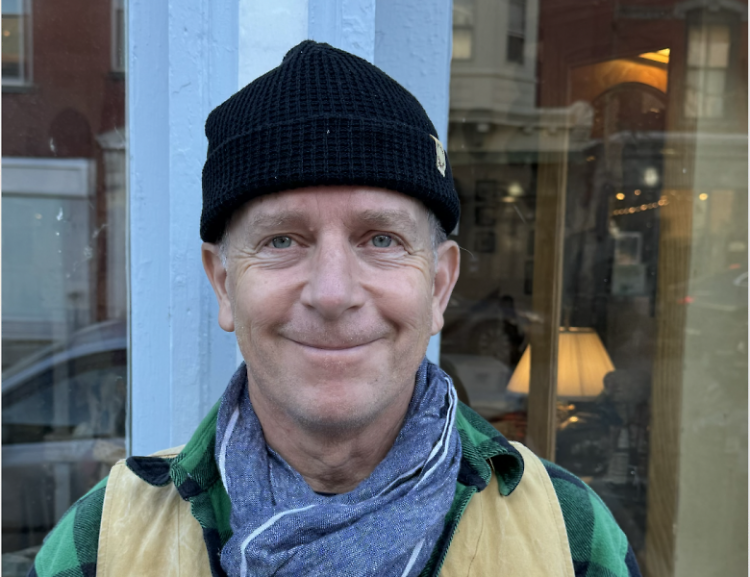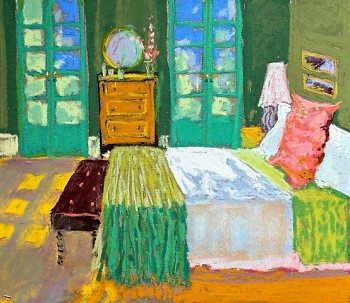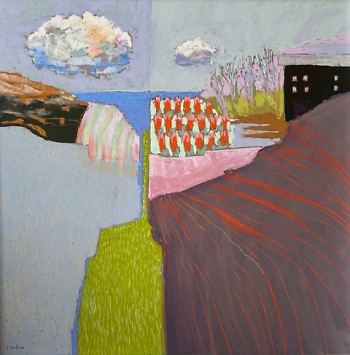It had better be fun…and Jeff Condon shows us how it can be. From the outside, the Tanglefoot Company warehouse building looks like so many other beautiful structures still remaining from another time in Grand Rapids history. Inside, right now, Jeff Condon and nine other artists create in studios that are custom built into the old warehouse space. Together, the artist workspaces comprise Tanglefoot Studios. Within a large undefined area on the second floor, Jeff constructed walls to encompass a welcoming gallery space and studio—a place to show, experience and make art.
So, did you build these walls and this space? Yes. It's a crazy old building, but it’s good. We’ve each built out our own spaces as a sanctuary for the creative process—we spend a lot of time here. So, this is mine—I keep this part set up as a gallery. There are six studios in the building—three upstairs, one next door and two in the other wing. It works out great. Elaine Dalcher is up from me. And you’ve probably heard of Tommy Allen and Michael Pfleghaar. They’re up another set of stairs.
Are you from Michigan? I am from the Upper Peninsula by Silver City in Ontonagan County, in the northwest corner. It was a copper mining town. I had 23 kids in my graduating class from high school. So, that's about how small it was. There was the copper mine and then my parents ran a resort, a hotel and restaurant, at the bottom of the Porcupine Mountains, which is the natural tourist attraction there. It was a rural area. My grandparents were dairy farmers from Croatia, but they also grew everything they ate. Strawberries, corn, lettuce, potatoes, tomatoes, cucumbers, onions. Anything they ate, they grew. And they sold the milk. They were pretty much totally self-sufficient. My grandma was embarrassed the first time she had to go into a grocery store and buy something that she didn’t produce. I think just seeing crops grow all the time and rows of corn or whatever it was—that was a huge influence growing up. Just seeing things grow or people making all their own food.
I went to Michigan State University from there. It was like ‘Wow, there's more people in this psychology class than my entire town.’ I floated around in Michigan State trying to figure out ‘What do you wanna do?’ as an 18-year-old kid from the U.P. Then, I took a graphic design class, and it was just like a light went off. I switched to Kendall, which brought me to Grand Rapids.
I finished a graphic design degree from Kendall and worked as graphic designer for a number of years. I started painting. Gradually, the graphics dropped off and the painting increased. So now I've been a full-time painter for 24 years. Fantastic…what every artist wants to do. Yeah, I do have to travel and go to art fairs all around the country May to September to make it work. They’re everywhere, from Petoskey up north to Kansas City, Missouri, and various spots in between. I have favorites now, and I pretty much stick with those. If you can get to a place where people know your work, they'll come back and take another look—to see what else they can collect…that kind of thing.
Was that graphic design class at Michigan State the first time you got into art, or do you have an earlier memory of an art experience? I always loved art since I was a kid. Art was always my favorite class, crafting in third grade and making stuff for parents. I specifically remember making this coat hanger duster where we tied all this yarn on a coat hanger to make the duster. You could pick whatever color yarn. Years later, when I started painting, I realized ‘These are literally the exact colors I picked for that coat hanger duster!’ So, I wonder sometimes if we all have this internal color palette that we naturally gravitate towards. Whether I do inside or outside paintings, it’s the same palette. So, I just jump between inside and outside, and I’m not really concerned that I've never seen a pink field or orange. It just becomes color and pattern for me.
How do you come up with your images. The interiors, are those real spaces? I have reference images like these from catalogues and magazines that I use for shapes, and I’ll just do a little sketch. Then, I'll say, ‘Okay, I'm gonna make these pillows orange or put this throw on the bed. Or, I'm gonna look across the bed in this way.’ So, it's pretty much all made up, using bits and pieces of other images. I like this image that has this chair in a shadow, so I might use that, but put it in a room. Or, I like this little dressing table—it intrigued me, so I saved that. I might just end up using that angle of the chair. Because I need a little help structure-wise with furniture. But the painting is a composite of things I chose.
I always loved Pierre Bonnard and Édouard Vuillard, the French impressionists who did interiors. That was always kind of my jumping off point, ‘Wow, they lived with a lot more texture and color than we do…their wallpapers and their fabrics and the women's dresses.’ We're pretty pared down in comparison. So, I try to do that same thing with color—not a lot of pattern, but a lot of really interesting colors. And narrative. You see this little scene I made—like what's this person doing here? They love to read, they kicked their shoes off. Maybe they were reading a magazine and this object there is something their kid brought home from school. So, I try to do a vignette into a life. There is no person in the painting, but it looks like someone just stepped out of the frame and we can only see evidence of what they were doing. I did a whole series of ‘shoes off’ where there’s always a pair of shoes that someone has kicked off. Here this one—there’s chairs for two people and two pairs of shoes. There’s this funky green color, where I’m pulling that in from a reflection and bouncing it off the pillow. So, my big thing is color and relationship to color. What does this orange do next to this turquoise? That’s what really interests me as much as the subject matter, I think.
I sold a lot of rooms this summer. These little vignettes are not necessarily accurate images— that the sun would come in and hit the floor like that maybe isn’t accurate, but everyone can recognize what it is, right? It’s impressionistic. Here, I can look at this room with the colors flowing over the edge of the bedspread and think, this is exactly the way I would have drawn water coming over something or a field. Or…it's just a bedspread. So, it's interesting to me that you're always seeing things where color makes them more than what they are.
How about these landscapes…do you come up with those images the same way? These all started with a trip to Sutton’s Bay and Traverse City, in northern Michigan. This was years and years ago. When we lived in the U.P. growing up, we would always drive down I-75. We never “took a right” as you might say, when we were coming down through that area. After I started painting, I thought ‘These hills, these old orchards, and these little farmhouses and outbuildings…there’s a little bit of seeing the lake here and there. There's little blue spots.’ So that was my jump into landscape—that area. I just found it really beautiful and interesting. I took photos and tried to absorb it all while I was there. And then, I started doing an art fair up there. So, every time I do the art fair in Sutton’s Bay, I always try to drive around and soak it in.
I feel like all these images we see, driving and whatever, they're going in somewhere. They're being registered somewhere in our brain and we're remembering them. And then I get back to the studio. It's up there somewhere in my mind, and it comes out on canvas. See this kind of crazy twisty line in this painting—I've walked through those brambles, and I walk through those crazy thorny patches on the hillsides. What did that feel like—this twisting and grabbing thing. And it turns out in color and pattern, what do color and pattern do to each other? So, for me, that's the fun of it. This is a barn with some crazy colored chickens. This—is it a field of poppies? For me, it’s just this really bold chunk of color. And then I go…where can I add a little more of this orange? It’s a study in composition, and it happens to be a landscape.
I really love clouds—playing with what they do to the piece. They’re usually the last thing I draw. I like this one–this one is called I Divided the Sky, because I never really thought of the sky as it though could be two things. And then I just realized, I can divide the sky vertically into two colors with a cloud on each side, with a sort of parent and child cloud. This straight line, almost a defines the whole painting, but not quite. All these rows of crops, fields, little orchard, some kind of barn shape, and then balancing the dark over here with this land again. That piece won a prize last year in Pastel Journal, which is a national pastel magazine. I don't enter a lot of contests, but I'll take it…the recognition is great.
Do you have any paintings that you just couldn't sell, because you love them too much? I do...and my wife does, too. She's pulled a few off the walls at art fairs. You get done with the one where everything worked and linked, and you think…'Oh, maybe I should keep that one.' We have two adult kids. One's a fashion designer, one's a schoolteacher, and I've given each of them favorites that I picked out for them. Then, it’s funny, because they would swap what I gave them. So maybe I didn’t read things quite right! This one is called Critter—that big orange alligator shape over the bed is based on something that my son drew in grade school. And it had to go in a painting. Which is fun.
So, how many paintings would you say you make per year, if you had to guess? Do you try to make one every day, or how do you organize that? 200 maybe? It’s always helpful if I have a deadline. I'm here at some point during the week, every week. And then in summer, I’m here every day when the art fair season is going on, because I have to have enough inventory. So, then I'll be making work almost every day, but in the winter, not so much. Then I'll work on some bigger commissions. I have a couple commissions of lined up now for bigger paintings. Those always take more thought and more planning, more everything.
What is the price range for your work? There’s a wide range from $25 for these little ones to $2000 or so for a large painting. The small-medium to medium-large pieces could range from $250 to $950. There’s a fairly broad scope. I sold a number of these medium-large paintings with this narrow vertical format for $875. That format kind of creates the feeling of looking through an open door. Those are the only two I have left, so I will do a few more of those for the December show.
Do you have a vision for the future, a ‘that would be amazing if this happened’ sort of thing, or are you just very happy with where you’re at? I would like to paint bigger, like take some of these images, not so much the rooms, but the landscapes…and just paint big, like four by four, four by six. I've done that in the past, but they are hard to move to art fairs because they're big, and they take up all your real estate. Maybe I will shift a little more abstract. You see this painting over here. This is kind of the thing I've done for a while, with clouds and a crazy landscape. But what I really love is this little piece of it in the lower right here, because it’s just like so juicy and colorful, just mark-making. What if that little part there was a whole painting, big shapes and textures. It's hard to make that jump, because I know what I want, but getting there is a learning curve. This little painting, I like a lot. It’s probably one of the more abstract ones I’ve got…I call it Boy, Lake, Dream. It's just this mixture of color, like this blue lake, this little dreamy atmosphere and, there’s something about it. What if that were bigger?
So, that's what I'm thinking. But in the meantime, I'll keep on doing the rooms, because I love the rooms. I never get tired of those. And people respond to them. I think there is really intrigue in this one here where there's some light coming in...that darkened hallway, because the sun is coming in over there.
What do you think your paintings mean to people? I do like doing the art fairs with direct contact with the buyer. I like to see how they react to the work. Architects really like my work because it's structural. Sometimes, someone will be looking at a painting, and I'll just say, 'Are you an architect?' You can tell. I have some great stories of why someone likes a piece. You might have no idea of how a little painting could mean so much to somebody. So, I enjoy the interaction and seeing someone's face light up or hear their story as to why they liked it. That kind of thing…there's been some incredible experiences over the years. I had a painting with a house floating above a cloud. This couple looked at it and walked away. Five minutes later, they came back and said ‘We need to buy this painting.’ He had had a double lung transplant the year before, and he said, ‘That's how we had to live. We had to live above the cloud.’ What they saw in that painting, living above something like a bad diagnosis wasn’t in my mind when I made it. But they saw that, and it was so cool that it meant something particular to them. They just felt they had to come back five minutes later and buy it.
With stuff like that, I get goosebumps. As artists, we're producing art with whatever's in us and in our spirit, but at the other end of the equation is the viewer and the person that purchases it. They complete the art or complete the experience, really. It's a joint experience. Those stories—if I want to think about quitting art…or I’ve done enough art. They’re always a good little message that ‘No, you could keep doing it. Okay. Not done yet.’ I'm still having fun, so I think that's the important part. I always say these are created with joy—I really enjoy what I paint. People walk into my tent and say ‘Oh, this just feels happy.’
Jeff Condon, Steff Condon, and potter Phil Wilson (Lots O’ Pots Pottery) will be hosting an open studio sale on December 6th from 5 to 9 pm and December 7th from 10 am to 4 pm at the Tanglefoot Studios, 314 Straight Avenue SW, Door K. See Instagram for details @jeffcondonart, @lotsopotspottery.
The Rapidian, a program of the 501(c)3 nonprofit Community Media Center, relies on the community’s support to help cover the cost of training reporters and publishing content.
We need your help.
If each of our readers and content creators who values this community platform help support its creation and maintenance, The Rapidian can continue to educate and facilitate a conversation around issues for years to come.
Please support The Rapidian and make a contribution today.


